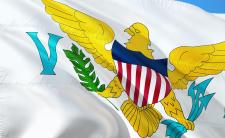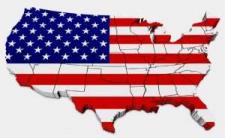Background
The United States of America consists of fifty states, one federal district and several territories. Forty-eight contiguous states sit between Mexico to the south and Canada to the north. Alaska, the forty-ninth state, is located to the west of Canada, and Hawaii, the fiftieth, is an island located in the Pacific Ocean.
Initially, the country was made up of a loose group of British colonies that had developed along the eastern shore of present day USA. The original thirteen colonies were New Hampshire, Massachusetts, Rhode Island, Connecticut, New York, New Jersey, Pennsylvania, Delaware, Maryland, Virginia, North Carolina, South Carolina, and Georgia. British rule within the colonies increased following the end of a six year war between Britain and the French in the northern territories. Relations between the colonies and Britain soon soured over lack of representation within the British Parliament and the increased taxation to pay for the war. The American Revolutionary War began in 1775. On July 4, 1776 the colonists adopted a Declaration of Independence from Britain. The short document had many innovations, such as the declaration that all men are created equal and that the people have the right to choose their governments. Needing a framework for a federal government to govern the thirteen independent states, the Second Continental Congress appointed a thirteen member committee to prepare a draft constitution. After a year of debates, the Articles of Confederation were completed on November 15, 1777, with the last state signing on November 20, 1778. However, because they vested almost all power in the states and gave very little authority to the federal government, the Articles soon led to confusion and infighting among the states, especially once the Revolutionary War ended in 1783.
Recognizing the need for a new system, a constitutional convention was organized to revise the Articles in May 1787. It was attended by delegates from the different states, drawn from all sectors of society. Despite its limited mandate to only revise the Articles of the Confederation, delegates decided to adopt a completely new instrument of government. Following further debates, the instrument was finally submitted to the states for ratification as a new Constitution in September 1787. One year later, in September 1788, the new Constitution came into effect.
1787 Constitution
A very short document consisting of seven articles, the Constitution was designed to set up a federal government of limited power and to protect the rights of the states. Articles I-III focus on the power and authority belonging to the three branches of the federal government: the Legislature, the Executive, and the Judiciary. Article IV addresses the relationship among the several states. Article V establishes the guidelines for amending the Constitution. Article VI declares the Constitution as the supreme law of the land, and Article VII describes the process of ratification. The Constitution, as ratified, did not provide for protection of civil liberties. These were established through the Constitution’s first ten Amendments, known as the Bill of Rights, in1789. These amendments limit the federal government’s abilities to restrain or dictate the behavior of the individual.
Including the Bill of Rights, the Constitution has been amended twenty-seven times. The 17 additional amendments have addressed several issues, including criminalizing slavery, introducing female suffrage, and ensuring the protection of voting rights. The most recent amendment, in 1992, established that any law changing the compensation of members of Congress would not take effect until after a new Congressional election had been held.
The Executive
Executive power is vested in the President, who serves a four-year term, renewable once. To qualify for the Presidency, an individual must be a natural born US citizen who has been a resident of the United States for at least fourteen years and is at least thirty-five years old. The President is the Head-of -State, Head-of-Government, and Commander-in-Chief of the Armed Forces. The President receives foreign diplomats and, with the consent of the Senate, makes treaties.
The Legislature
All legislative power, both enumerated and implied, granted to the federal government vest in the Congress comprised of the House of Representatives and the Senate. Representatives must be at least twenty-five years old, be a citizen of the United States for seven years, and live in the district they represent. Senators must be at least 30 years old, be a citizen for nine years, and live in the state they represent. Representatives are directly elected for a two-year term, while Senators serve six. The Vice President serves as the President of the Senate. An overturn of a President’s veto requires a two-third majority from both Houses. Article I, Section 8 enumerates the legislative powers, which include: To make all laws which shall be necessary and proper for carrying into execution the foregoing powers, to provide for the common welfare, to provide for and maintain the armed forces, to borrow money and to declare war. The Constitution also gives Congress the power to regulate foreign and interstate commerce.
The Judiciary
The Constitution vests the judicial power of the United States in the Supreme Court and any other inferior courts that may be created. In all cases affecting ambassadors, other public ministers and consuls, and those in which a state is a party, the Supreme Court has original jurisdiction. In all the other cases before mentioned, the Supreme Court has appellate jurisdiction, both as to law and fact, with such exceptions, and under such regulations as the Congress shall make. Because the Court has jurisdiction over issues arising under the Constitution, it has the power of judicial review. The court can decide whether the actions taken by the states, the executive, or the legislature are constitutional. Supreme Court Justices are nominated by the President and confirmed by a majority of the Senate. Justices have a lifetenure, unless he or she retires or is impeached.
System of Government
Timeline
| 11 November 1620 |
First government document, the Mayflower Compact, is signed. |
| 19 October 1765 |
Stamp Act Congress: A congress of delegates from nine colonies adopted the Declaration of Rights and Grievances, which petitioned Parliament and the King to repeal the Stamp Act. |
| 18 March 1788 |
The British Parliament repealed the Stamp Act and issued the Declaratory Act, which asserted its "full power and authority to make laws and statutes... to bind the colonies and people of America... in all cases whatsoever." |
| 1774 |
First Continental Congress |
| 1775 |
Second Continental Congress |
| 1775 |
American Revolution commences. |
| 4 July 1776 |
Declaration of Independence is signed by Congress |
| 15 November 1777 |
Second Continental Congress adopts the Articles of Confederation. |
| 1781 |
The 13 original states form a loose confederation, codified in the Articles of Confederation |
| 3 September 1783 |
Treaty of Paris ends the Revolutionary War and creates new United States of America |
| 1787 |
New Constitution drafted to address the weakness of the federal government |
| 1789 |
Constitution becomes law and George Washington is elected the first president |
| 1791 |
First 10 Amendments to the Constitution, Bill of Rights, are ratified |
| 1803 |
Marbury v. Madison - The Supreme Court establishes the principle of Judicial Review. |
| 1804 |
Twelfth Amendment - amends the procedure for electing the president and vice president |
| 1808 |
Atlantic slave trade abolished |
| 1819 |
McCulloch v. Maryland – Supreme Court ruling prohibited state laws from infringing upon federal Constitutional authority. |
| 1860 |
Anti-slavery Republican Party candidate Abraham Lincoln is elected president |
| 1861 |
Eleven pro-slavery southern states secede from Union and form Confederate States of America under leadership of Jefferson Davis, triggering civil war with abolitionist northern states |
| 1 January 1863 |
Lincoln issues the Emancipation Proclamation, freeing slaves in the secessionist states |
| 1865 |
Confederates are defeated, and slavery is abolished under the Thirteenth Amendment |
| 1868 |
The Fourteenth Amendment to the United States Constitution, second of the Reconstruction Amendments, was ratified. |
| 1875 |
Civil Rights Act of 1875: Enforcement act guaranteeing African Americans equal treatment in public accommodations, public transportation, and prohibited exclusion from jury service. |
| 1882 |
Chinese Exclusion Act – banning migration of all Chinese laborers – passed |
| 1883 |
Supreme Court declares the Civil Rights Act of 1875 unconstitutional |
| 1883 |
Plessey v. Ferguson – Supreme Court deems “separate but equal” facilities on the basis of race constitutionally valid |
| 1913 |
Seventeenth Amendment - establishes direct elections of Senators by state citizens |
| 1920 |
Nineteenth Amendment gives women the right to vote |
| 1924 |
Indian Citizen Act of 1924 - Congress gives indigenous people the rights of citizenship. |
| 1950-54 |
McCarthyism takes hold of the nation, suppressing all communism and all those suspected of being communist. |
| 1954 |
Brown v. Board of Education – Supreme Court overturns Plessey v. Ferguson, declaring that separate facilities were not equal |
| 1992 |
27th Amendment changes when laws for Congressional compensation take effect |
Bibliography
The Charters of Freedom. Constitution of the United States A History. Web. 2013 July 7. http://tinyurl.com/n4s654.
Scholastic. How the US Constitution Has Evolved Over Time. Web. 2013 July 7. http://tinyurl.com/qjmjccq.
Historical Boys Clothing. American History: The Constitution. Web. 2013 July 7. http://tinyurl.com/ne4uo72 .
Congressional Research Service Library of Congress. The Constitution of the United States of America: Analysis and Interpretation. Web. 2013 July 7. (available at http://constitution.org/cons/GPO-CONAN-2002.pdf).
BBC News. United States Country Profile., 2011. Web. 2013 July 7.http://www.bbc.co.uk/news/world-us-canada-16761057.
United States. CIA World Factbook: United States. Web. 2013 July 7.http://tinyurl.com/2l9rcv.
| Branch | Hierarchy | Powers | Removal |
|---|






Share this article